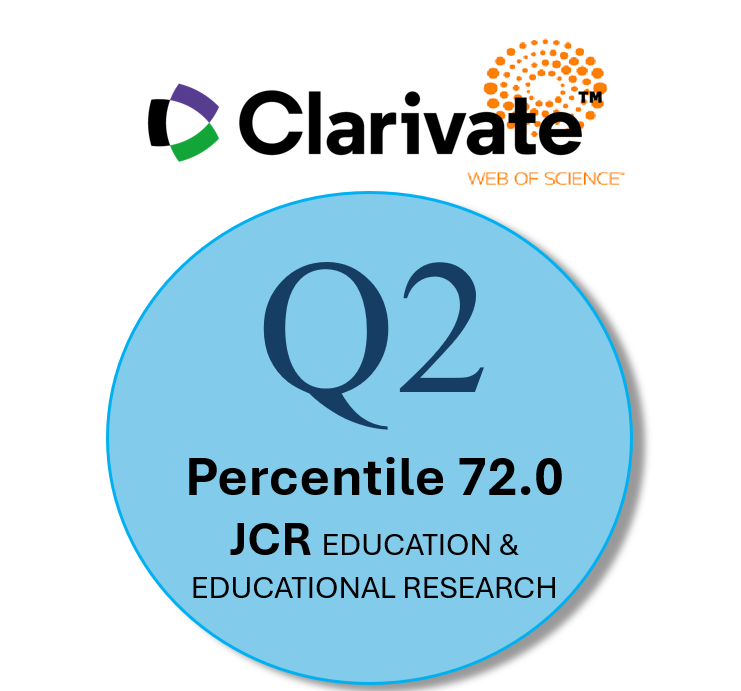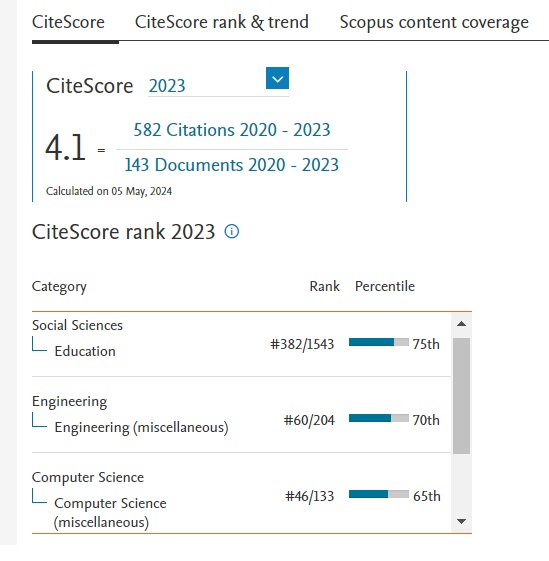Aprovechar la toma de decisiones dinámica y el análisis ambiental para respaldar experiencias de aprendizaje auténticas en entornos digitales
Agencias de apoyo
- None
Resumen
Authentic learning is a pedagogical approach that situates students in real-world settings. Authentic learning experiences in online environments allow learners to solve real-world problems when they immerse in real-world settings. It thereby requires instructional designers to make contextualized design decisions to enhance students’ online authentic learning experiences. The purpose of this paper is to provide instructional designers with a conceptual framework to help guide their instructional design decisions for authentic learning experiences in online environments. We purport that these design decisions should be guided by three constructs: authentic learning, decision-making, and contextual analysis. We also provide recommendations for future research on decision-making practices and processes in instructional design contexts.
Descargas
-
Resumen1321
-
PDF 1018
Citas
Authors (2014)
Authors (2017)
Authors (2018a)
Authors (2018b)
Authors (2019)
Authors (2020)
Al Mamun, M. A., Lawrie, G., & Wright, T. (2020). Instructional design of scaffolded online
learning modules for self-directed and inquiry-based learning environments. Computers
& Education, 144, 103695.
anak Marcus, V. B., Atan, N. A., Jumaat, N. F., Junaidi, J., & Said, M. N. H. M. (2018).
Improving student’s learning outcomes through e-service learning based on authentic
learning strategy. Innovative Teaching and Learning Journal, 2(1), 8-16.
Arias, S., & Clark, K. A. (2004). Instructional technologies in developing countries: A
contextual analysis approach. TechTrends, 48(4), 52-55.
Arthur, W. B. (1994). Inductive reasoning and bounded rationality. The American Economic
Review, 84(2), 406-411.
Baaki, J., & Tracey, M.W. (2019). Weaving a localized context of use: What it means for
instructional design. Journal of Applied Instructional Design, 8(1), 1-13.
Barsalou, L. W. (2015). Situated conceptualization: Theory and applications. In Y. Coello & M.
H. Fischer (Eds.), Perceptual and emotional embodiment: Foundations of embodied
cognition (pp. 19–45). New York, NY: Routledge.
Colton, A. B., & Sparks-Langer, G. M. (1993). A conceptual framework to guide the
development of teacher reflection and decision making. Journal of Teacher Education,
(1), 45-54.
Cross, N. (2011). Design thinking. New York, NY: Berg.
Cui, G., Lockee, B., & Meng, C. (2013). Building modern online social presence: A review of
social presence theory and its instructional design implications for future trends.
Education and information technologies, 18(4), 661-685.
Czerkawski, B. C., & Lyman, E. W. (2016). An instructional design framework for fostering
student engagement in online learning environments. TechTrends, 60(6), 532-539.
De Martino, B., Kumaran, D., Seymour, B., & Dolan, R. J. (2006). Frames, biases, and rational
decision-making in the human brain. Science, 313(5787), 684-687.
Endsley, M. R. (1995). Measurement of situation awareness in dynamic systems. Human
Factors, 37(1), 65-84.
Ertmer, P. A., & Cennamo, K. S. (1995). Teaching instructional design: An apprenticeship
model. Performance improvement quarterly, 8(4), 43-58.
Ertmer, P. A., & Koehler, A. A. (2014). Online case-based discussions: Examining coverage of
the afforded problem space. Educational Technology Research and Development, 62(5),
-636.
Ertmer, P. A., Sadaf, A., & Ertmer, D. J. (2011). Student-content interactions in online courses:
The role of question prompts in facilitating higher-level engagement with course content.
Journal of Computing in Higher Education, 23(2-3), 157.
Ertmer, P.A., Stepich, D.A., York, C., S., Stickman, A., Wu, X.L., Zurek, S., & Goktas, Y.
(2008). How instructional design experts use knowledge and experience to solve ill-
structured problems. Performance Improvement Quarterly, 21(1), 17-42.
García-Cabrero, B., Hoover, M. L., Lajoie, S. P., Andrade-Santoyo, N. L., Quevedo-Rodríguez,
L. M., & Wong, J. (2018). Design of a learning-centered online environment: a cognitive
apprenticeship approach. Educational Technology Research and Development, 66(3),
-835.
Gigerenzer, G. (2004). Fast and frugal heuristics: The tools of bounded rationality. In D.J.
Koehler & N. Harvey (Eds.), Blackwell handbook of judgment and decision making
(pp.62-88). New York, NY: Wiley & Sons.
Gillett-Swan, J. (2017). The challenges of online learning: Supporting and engaging the isolated
learner. Journal of Learning Design, 10(1), 20-30.
Gray, C. M., Dagli, C., Demiral‐Uzan, M., Ergulec, F., Tan, V., Altuwaijri, A. A., ... & Boling,
E. (2015). Judgment and Instructional Design: How ID Practitioners Work In Practice.
Performance Improvement Quarterly, 28(3), 25-49.
Hall, A.D., & Fagen, R.E. (1975). Definition of system. In B.D. Ruben & J.Y. Kin (Eds.),
General systems theory and human communication (pp. 52-65). Rochelle Park, NJ:
Hayden Book Company, Inc.
Herrington, J. (2006, October). Authentic e-learning in higher education: Design principles for
authentic learning environments and tasks. In E-Learn: World Conference on E-Learning in Corporate, Government, Healthcare, and Higher Education (pp. 3164-3173). Association for the Advancement of Computing in Education (AACE).
Herrington, J., & Oliver, R. (2000). An instructional design framework for authentic learning
environments. Educational Technology Research and Development, 48(3), 23-48.
Herrington, J., Oliver, R., & Reeves, T. C. (2003). Patterns of engagement in authentic online
learning environments. Australasian Journal of Educational Technology, 19(1).
Herrington, J., Reeves, T. C., & Oliver, R. (2014). Authentic learning environments. In
Handbook of research on educational communications and technology (pp. 401-412).
New York, NY: Springer.
Herrington, J., Reeves, T. C., & Oliver, R. (2007). Immersive learning technologies: Realism and
online authentic learning. Journal of Computing in Higher Education, 19(1), 80-99.
Jonassen, D.H. (1997). Instructional design model for well-structured and ill-structured problem-
solving learning outcomes. ETR&D, 45(1), 65-95.
Jonassen, D.H. (2000). Toward a design theory of problem solving. ETR&D, 48(4), 63-85.
Jonassen, D. H. (2010). Learning to solve problems: A handbook for designing problem-solving
learning environments. New York, NY: Routledge.
Jonassen, D. H. (2012). Designing for decision making. Educational Technology Research and
Development, 60(2), 341-359.
Kahneman, D. (2003). A perspective on judgment and choice: mapping bounded rationality.
American Psychologist, 58(9), 697-720.
Keengwe, J., & Kidd, T. T. (2010). Towards best practices in online learning and teaching in
higher education. MERLOT Journal of Online Learning and Teaching, 6(2), 533-541.
Kentnor, H. E. (2015). Distance education and the evolution of online learning in the United
States. Curriculum and Teaching Dialogue, 17(1), 21-34.
Klein, G. (1998). Sources of power: How people make decisions. Cambridge, MA: MIT Press.
Klein, G. (2008). Naturalistic decision making. Human Factors, 50(3), 456-460.
Kopcha, T.J., Neumann, K.L., Ottenbreit-Leftwich, A., & Pitman, E. (2020). Process over
product: The next evolution of our quest for technology integration. Educational
Technology, Research, and Development.
Lai, P. K., Portolese, A., & Jacobson, M. J. (2017). Does sequence matter? Productive failure
and designing online authentic learning for process engineering. British Journal of
Educational Technology, 48(6), 1217-1227.
Lowenthal, P. R., & Dennen, V. P. (2017). Social presence, identity, and online learning:
research development and needs. Distance Education, 38(2), 137-140.
Luo, H., Koszalka, T. A., Arnone, M. P., & Choi, I. (2018). Applying case-based method in
designing self-directed online instruction: a formative research study. Educational
Technology Research and Development, 66(2), 515-544.
Meloncon, L.K. (2017). Patient experience design: Expanding usability methodologies for
healthcare. Communication Design Quarterly, 5(2), 20-28.
Nutt, P.C. (2008). Investigating the success of decision-making processes. Journal of
Management Studies, 45(2), 425-455.
Paris, S.G., Lipson, M.Y., & Wixson, K.K. (1983). Becoming a strategic reader. Contemporary
Educational Psychology, 8, 293-316.
Parker, J., Maor, D., & Herrington, J. (2013). Authentic online learning: Aligning learner needs,
pedagogy and technology. Issues in Educational Research, 23(2), 227.
Parrish, P. E. (2009). Aesthetic principles for instructional design. Educational
Technology Research and Development, 57, 511-528.
Perkins, R. A. (2003). The role of context in instructional design: A case study examining the re-
purposing of Web-based master's degree courses for use in Malawi (Doctoral
dissertation, Virginia Tech).
Perkins, R. A. (2008). Challenges and questions concerning “culturally-sensitive
design.”TechTrends, 52(6), 19-21.
Richardson, J. C., Maeda, Y., Lv, J., & Caskurlu, S. (2017). Social presence in relation to
students' satisfaction and learning in the online environment: A meta-analysis. Computers
in Human Behavior, 71, 402-417.
Richardson, J. C., Sadaf, A., & Ertmer, P. A. (2013). Relationship between types of question
prompts and critical thinking in online discussions. In Educational communities of
inquiry: Theoretical framework, research and practice (pp. 197-222). Hershey, PA: IGI
Global.
Richey, R.C., & Tessmer, M. (1995). Enhancing instructional systems design through contextual
analysis. In B.B. Seels (Ed.), Instructional design fundamentals: A reconsideration (pp.
-199). Englewood Cliffs, NJ: Educational Technology Publications.
Rule, A. C. (2006). The components of authentic learning. Journal of Authentic Learning, 3(1),
-10.
Sanga, M. W. (2017). Closing gap between learning and use: Operationalizing the situated
cognition construct to create authentic online learning contexts. The Online Journal of
Distance Education and E-Learning, Contents, 5(3).
Sharma, P., & Hannafin, M. (2004). Scaffolding critical thinking in an online course: An
exploratory study. Journal of Educational Computing Research, 31(2), 181-208.
Simon, H.A. (1957). Models of man. New York, NY: Wiley & Sons.
Simon, H. A. (1972). Theories of bounded rationality. Decision and Organization, 1(1), 161-176.
Simonson, M. (2005). Entering the mainstream: Distance education and higher education.
Quarterly Review of Distance Education, 6(1), VII.
Spector, J. M. (2018). Future trends of designing learning in the global context. In Authentic
Learning Through Advances in Technologies (pp. 205-216). Springer, Singapore.
Stark, R., Kopp, V., & Fischer, M. R. (2011). Case-based learning with worked examples in
complex domains: Two experimental studies in undergraduate medical education.
Learning and Instruction, 21(1), 22-33.
Stone, M. T., & Perumean-Chaney, S. (2011). The benefits of online teaching for traditional
classroom pedagogy: A case study for improving face-to-face instruction. MERLOT
Journal of Online Learning and Teaching, 7(3), 393-400.
Swan, K. (2002). Building learning communities in online courses: The importance of
interaction. Education, Communication & Information, 2(1), 23-49.
Tessmer, M. (1990). Environment analysis: A neglected stage of instructional design.
Educational Technology Research and Development, 38(1), 55-64.
Tessmer, M. (1991). Back to the future: The environment analysis stage of front-end analysis.
Performance and instruction, 30(1), 9-12.
Tessmer, M., & Harris, D. (1990). Beyond instructional effectiveness: Key environmental
decisions for instructional designers as change agents. Educational Technology, 30(7),
-20.
Tessmer, M., & Richey, R. C. (1997). The role of context in learning and instructional design.
Educational Technology Research and Development, 45(2), 85-115.
Tessmer, M., & Wedman, J. F. (1992). Decision‐making factors and principles for selecting a
layer of instructional development activities. Performance+ Instruction, 31(4), 1-6.
Tessmer, M., & Wedman, J. (1995). Context‐sensitive instructional design models: A response to
design research, studies, and criticism. Performance Improvement Quarterly, 8(3), 38-54.
Yanchar, S. C., & Gabbitas, B. W. (2011). Between eclecticism and orthodoxy in instructional
design. Educational Technology Research and Development, 59(3), 383-398.
Las obras que se publican en esta revista están sujetas a los siguientes términos:
1. El Servicio de Publicaciones de la Universidad de Murcia (la editorial) conserva los derechos patrimoniales (copyright) de las obras publicadas, y favorece y permite la reutilización de las mismas bajo la licencia de uso indicada en el punto 2.
2. Las obras se publican en la edición electrónica de la revista bajo una licencia Creative Commons Reconocimiento-NoComercial-SinObraDerivada 3.0 España (texto legal). Se pueden copiar, usar, difundir, transmitir y exponer públicamente, siempre que: i) se cite la autoría y la fuente original de su publicación (revista, editorial y URL de la obra); ii) no se usen para fines comerciales; iii) se mencione la existencia y especificaciones de esta licencia de uso.
3. Condiciones de auto-archivo. Se permite y se anima a los autores a difundir electrónicamente las versiones pre-print (versión antes de ser evaluada) y/o post-print (versión evaluada y aceptada para su publicación) de sus obras antes de su publicación, ya que favorece su circulación y difusión más temprana y con ello un posible aumento en su citación y alcance entre la comunidad académica. Color RoMEO: verde.














